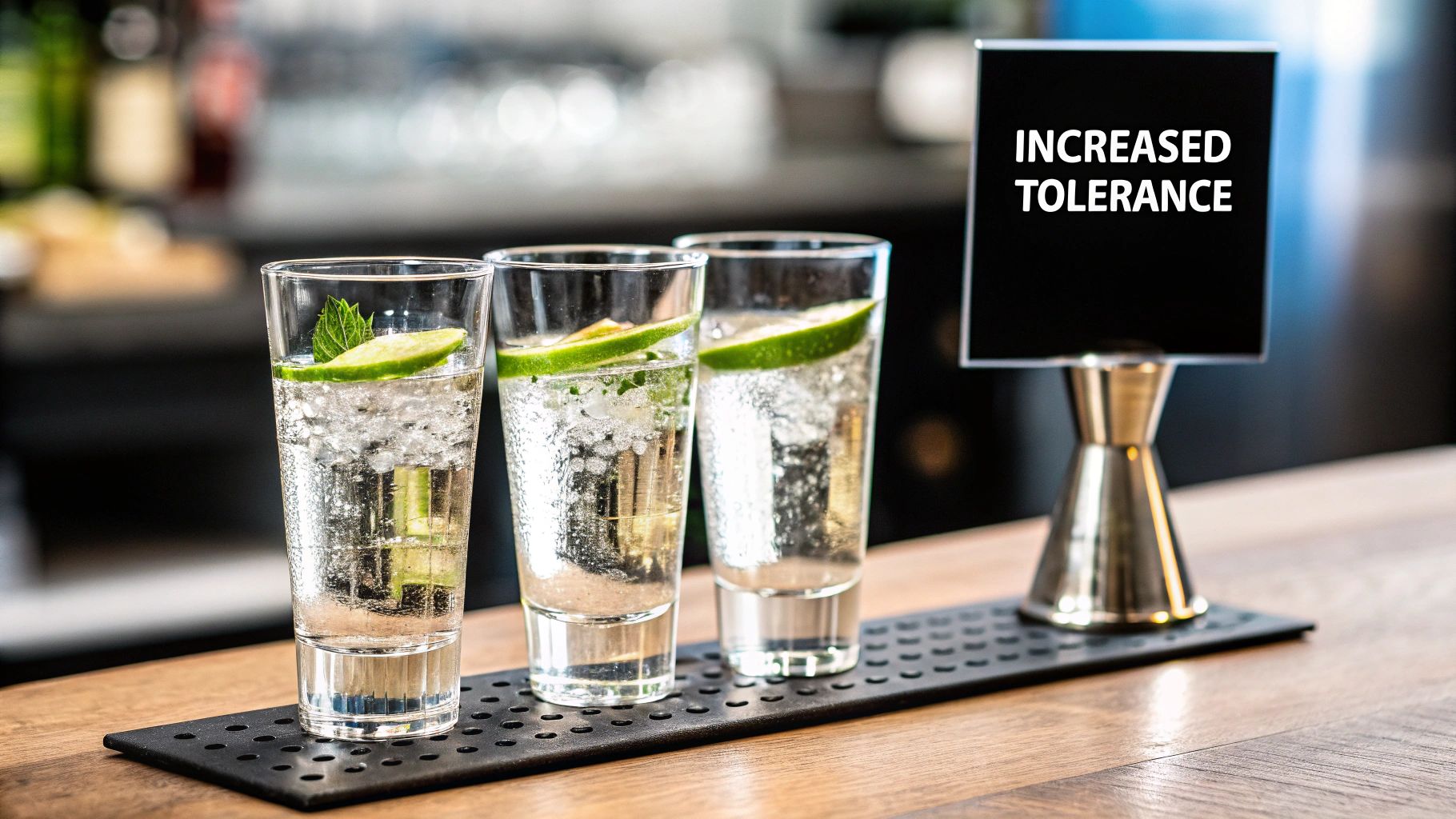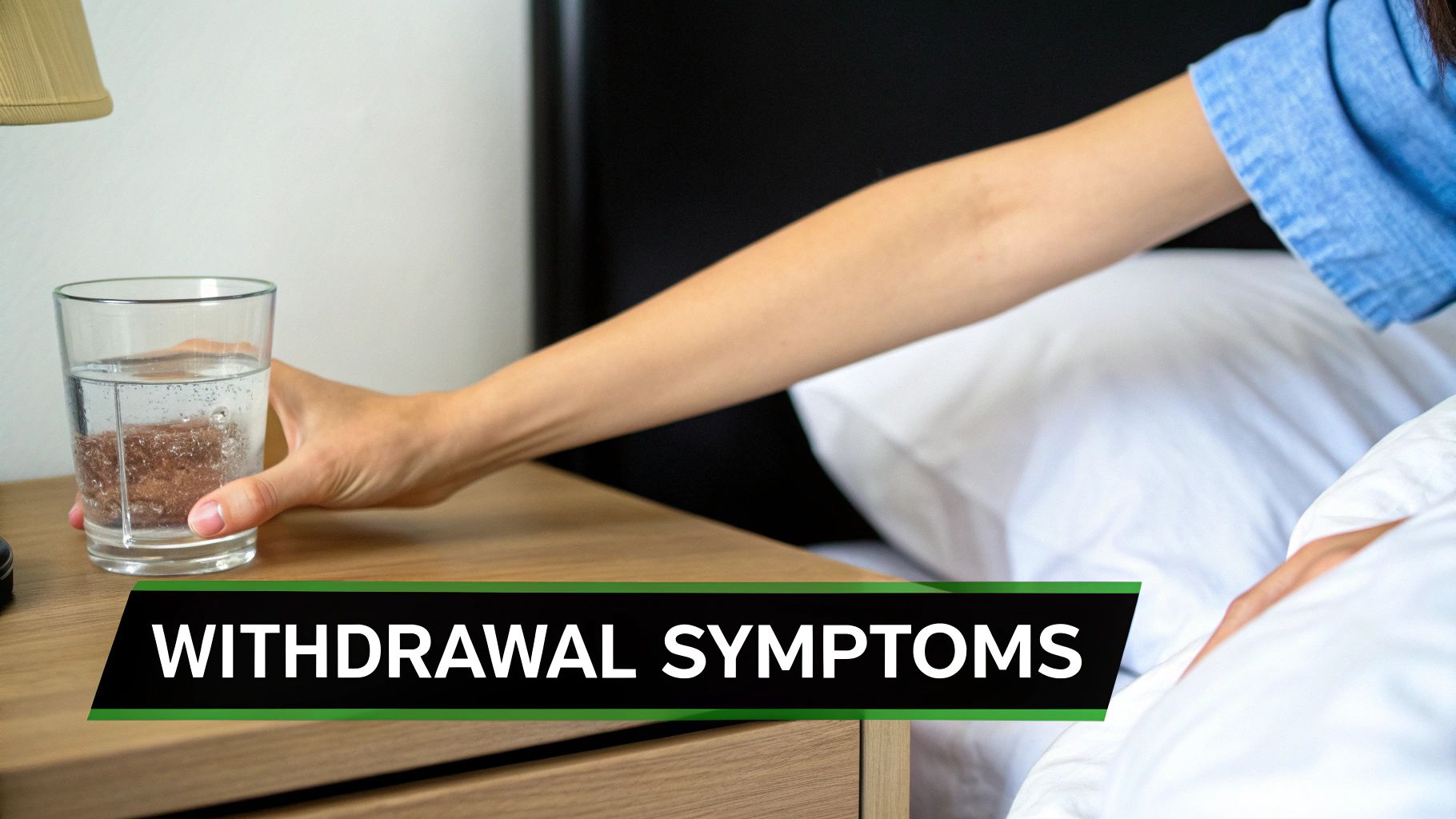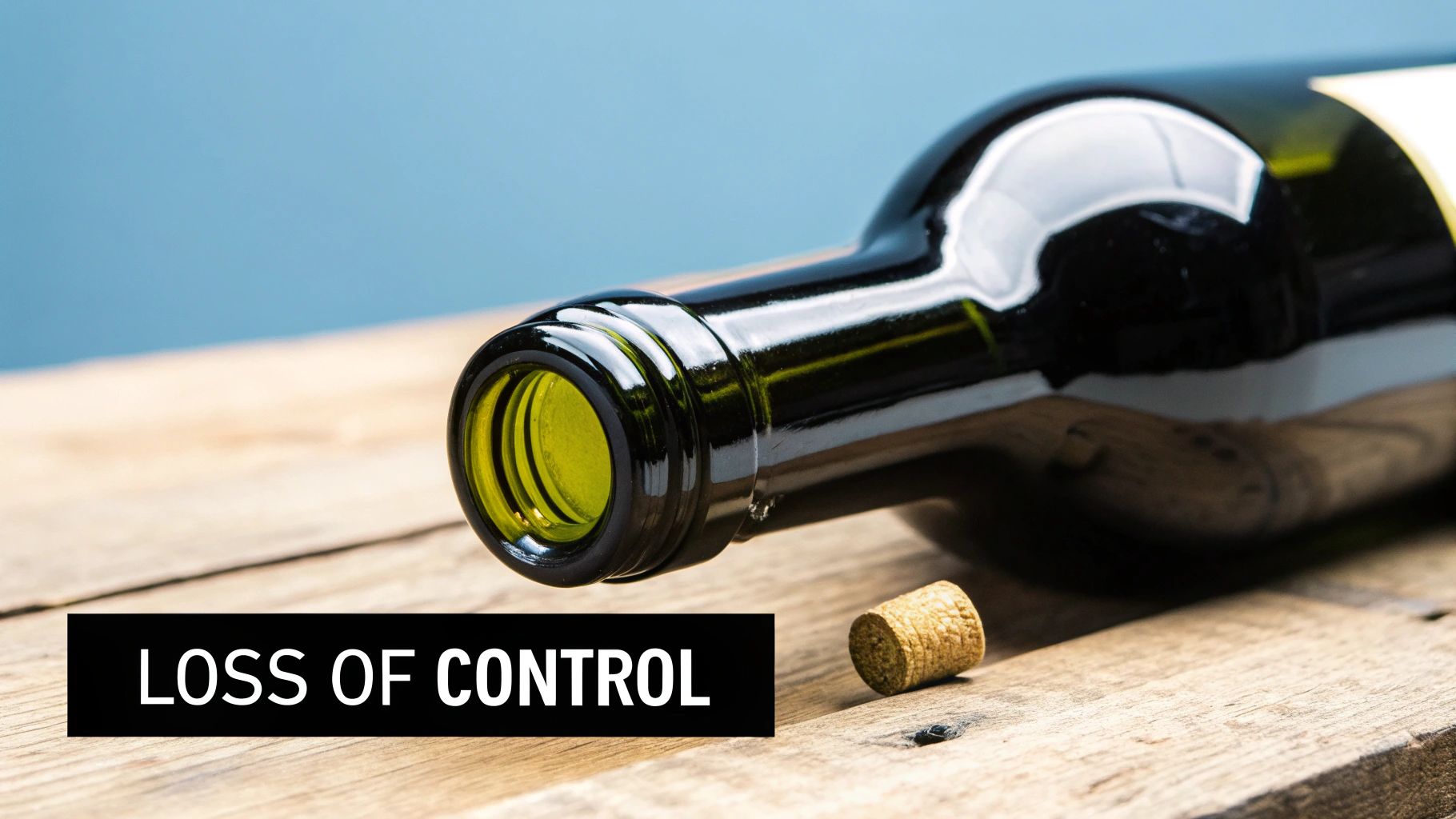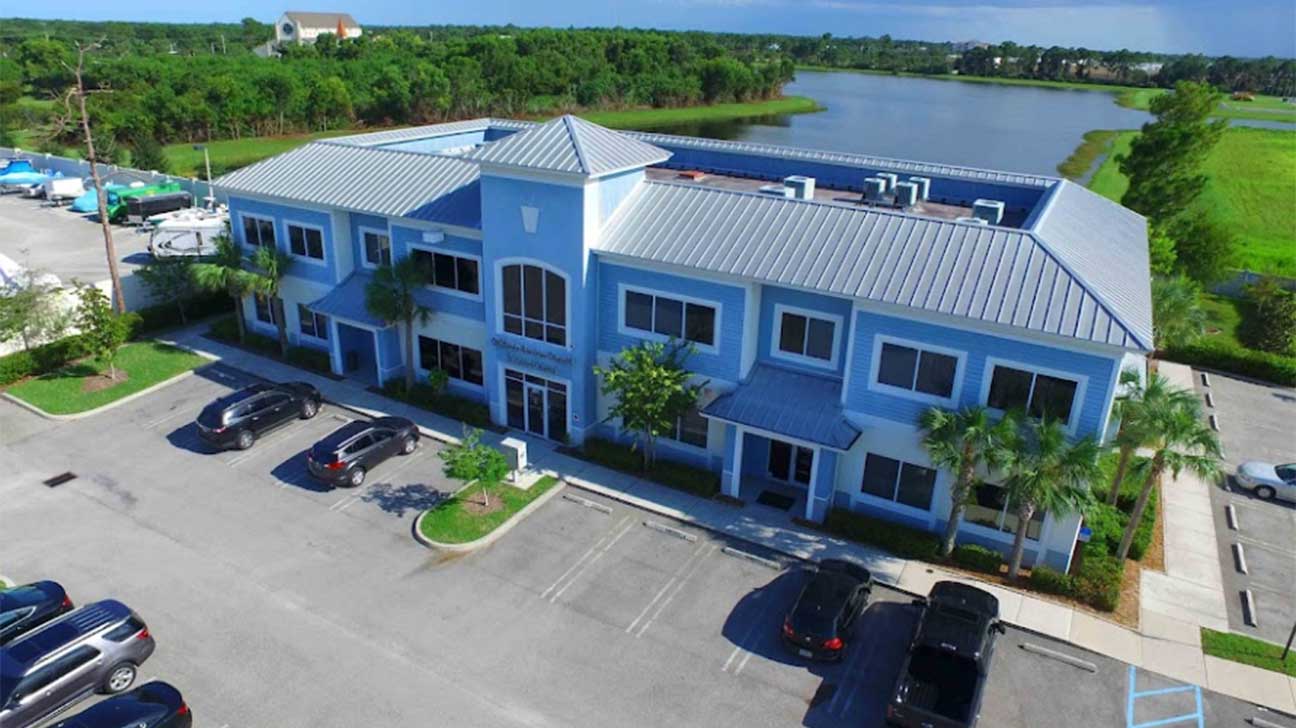
It often starts innocently: a drink to unwind, a social toast, a way to celebrate. But for millions of Americans, the line between casual use and dependency becomes blurred. Recognizing the subtle and overt signs of alcohol addiction is the first, most crucial step toward regaining control for yourself or helping a loved one. This is not about judgment; it is about awareness. Understanding these indicators provides the clarity needed to seek help before the consequences escalate.
This guide moves straight to the point, breaking down the eight most common physical, behavioral, and psychological signs of alcohol use disorder. For each sign, we will provide clear examples and actionable insights to help you identify a potential problem and understand what to do next. Let’s explore the patterns that signal when alcohol consumption has crossed the line from a habit into an addiction.
1. Increased Tolerance
One of the most significant physiological signs of alcohol addiction is developing an increased tolerance. This means your body has adapted to the presence of alcohol, requiring you to consume progressively larger amounts to feel the same effects you once did with smaller quantities. This isn’t a sign of strength; it’s a critical warning that your brain chemistry is changing to compensate for regular, heavy drinking.

When this happens, what was once a single glass of wine to unwind might become three or four. Tolerance can make it seem like you can “hold your liquor” well, but it’s a deceptive indicator of a growing physical dependency.
How to Recognize Increased Tolerance
Monitoring your consumption patterns is key to identifying this early sign of alcohol addiction. Pay close attention if you notice:
- Shifting Quantities: You now need a six-pack to achieve the buzz you used to get from two beers.
- Switching Drinks: You’ve moved from beer or wine to hard liquor like whiskey or vodka to feel the desired effect more quickly.
- External Comments: Friends or family express surprise at how much you can drink without seeming intoxicated.
Tracking your intake in a journal for a few weeks can provide a clear, objective view of how your tolerance has shifted, helping you recognize the pattern before it progresses further.
2. Withdrawal Symptoms
Experiencing physical and psychological withdrawal symptoms is one of the most definitive signs of alcohol addiction. When your body becomes dependent on alcohol, it adapts to its constant presence. If you suddenly stop or significantly reduce your drinking, your central nervous system, which was suppressed by alcohol, becomes overactive. This rebound effect triggers a range of uncomfortable and potentially dangerous symptoms.

This process is your body’s attempt to regain balance without the substance it has grown to rely on. The need to drink simply to stave off these feelings, often called a “morning eye-opener,” is a classic indicator that a physical dependency has formed, shifting drinking from a choice to a necessity. You can learn more about the alcohol withdrawal timeline on addictionhelplineamerica.com.
How to Recognize Withdrawal Symptoms
Withdrawal can manifest in subtle or severe ways, often appearing within hours of your last drink. Be aware if you experience:
- Physical Discomfort: You wake up with tremors or “the shakes,” have a persistent headache, feel nauseous, or begin sweating for no apparent reason.
- Emotional Distress: You feel an overwhelming sense of anxiety, irritability, or restlessness when you are not drinking.
- Compulsive Drinking: You find yourself drinking in the morning or throughout the day just to feel “normal” and keep these negative symptoms at bay.
Recognizing that you’re drinking to avoid discomfort rather than for pleasure is a critical sign of alcohol addiction. Because withdrawal can be severe, it is vital to seek medical supervision before attempting to detox.
3. Loss of Control Over Drinking
A defining characteristic of alcohol addiction is losing control over your consumption. This means you are consistently unable to stick to the limits you set for yourself. You might intend to have just one drink but find yourself finishing the entire bottle, or a planned quiet night in escalates into a heavy drinking session that lasts for hours longer than intended. This pattern reveals that the decision to drink is no longer entirely voluntary.

This loss of control is a powerful sign that alcohol has started to hijack your brain’s reward and decision-making pathways. Despite recognizing the negative consequences, such as arguments with loved ones or poor performance at work, the compulsion to continue drinking overrides your better judgment.
How to Recognize a Loss of Control
Identifying this sign of alcohol addiction requires honest self-reflection about your drinking habits and intentions versus reality. You might be losing control if you notice:
- Broken Promises: You frequently promise yourself or others that you will cut back or quit, but repeatedly fail to do so.
- Unintended Binges: You plan to have only a couple of drinks at a social event but end up drinking to excess, sometimes to the point of blacking out.
- Failed Moderation: Your attempts to moderate your drinking are consistently unsuccessful, proving you cannot reliably manage your intake once you start.
Keeping a log of your intended consumption versus what you actually drank can make this pattern undeniable, highlighting a core symptom of alcohol use disorder.
Call Now – Your Journey to Recovery Begins Today!

Take the first step towards a healthier life! Call now to connect with our compassionate team and start your recovery journey today. Your path to healing awaits!
Our recovery specialists are available 24/7 to provide support, and all calls are confidential and free. Reach out anytime – we’re here to help!
4. Preoccupation with Alcohol
When alcohol shifts from a casual part of social events to a central focus of your thoughts, it’s a significant behavioral sign of alcohol addiction. This mental preoccupation involves constantly thinking about your next drink, planning your day around opportunities to consume alcohol, and ensuring it’s always available. This cognitive obsession indicates that alcohol has taken on an outsized importance in your life, often overshadowing responsibilities, relationships, and hobbies.

This fixation can dictate your choices, from where you go for dinner to which social invitations you accept. It creates a cycle where your mental energy is increasingly spent planning, obtaining, and recovering from alcohol use, which is a powerful indicator of dependency. This preoccupation is also a common challenge during recovery; you can learn more about relapse warning signs to better understand the recovery journey.
How to Recognize Preoccupation with Alcohol
Identifying this mental shift requires self-awareness of your daily thought patterns and decision-making processes. Look for these behaviors:
- Strategic Planning: You consistently choose restaurants based on their drink menu or check liquor store hours before making other plans.
- Event Anxiety: You feel anxious or irritable about attending events, like a child’s birthday party or a work meeting, where alcohol will not be served.
- Clock-Watching: You find yourself frequently counting down the hours or minutes until you feel it’s an “acceptable” time to have your first drink.
Paying close attention to how much of your mental real estate is occupied by alcohol-related thoughts can reveal the extent to which it has become a priority, highlighting a critical sign of alcohol addiction.
5. Neglecting Responsibilities and Relationships
A powerful behavioral sign of alcohol addiction is the progressive neglect of major life responsibilities. As drinking becomes a central focus, obligations at work, home, and within social circles are often pushed aside. This shift happens when the need to consume alcohol starts to outweigh the importance of commitments that were once priorities.
This isn’t just about forgetting an occasional appointment; it’s a consistent pattern of poor performance and unreliability. You might find yourself calling in sick to work because of a hangover, missing a child’s school event, or letting household chores and bills pile up. When family members are impacted, it can cause significant strain, and there are resources for families of addicts that can help. This neglect is a clear indicator that alcohol is taking control.
How to Recognize Neglect of Responsibilities
Observing how your actions and priorities have changed is crucial for identifying this troubling sign of alcohol addiction. Be honest with yourself and look for these patterns:
- Work or School Issues: Your performance is declining, you’re frequently late, or you miss deadlines due to drinking or its aftereffects.
- Family Conflicts: You’re missing important family events, breaking promises to loved ones, or sparking arguments because of your unreliability.
- Social Isolation: You cancel plans with friends to drink instead or avoid social situations where you can’t drink freely.
Taking an inventory of your commitments versus your actual follow-through can highlight how much alcohol has begun to interfere with your life and the lives of those around you.
6. Drinking Despite Negative Consequences
One of the most telling signs of alcohol addiction is continuing to drink even when it causes clear and significant problems in your life. This persistence, despite obvious harm, highlights the compulsive nature of addiction, where the drive to drink overrides rational decision-making and judgment. The alcohol use disorder has taken priority over health, relationships, and responsibilities.
When the consequences of drinking, such as legal trouble, job loss, or health crises, are not enough to make someone stop, it indicates a severe loss of control. This pattern demonstrates that the perceived need for alcohol outweighs the very real, negative impacts it has on a person’s well-being and stability.
How to Recognize This Pattern
Connecting the dots between your drinking and life’s problems is the first step. Look for these red flags:
- Relationship Strain: You continue drinking after your spouse threatens divorce or your family expresses deep concern about your alcohol use.
- Health Issues: You receive a diagnosis for a condition like liver disease or high blood pressure directly linked to alcohol, yet you don’t stop drinking.
- Financial Problems: You prioritize buying alcohol over paying bills or essential expenses, causing significant financial strain.
- Legal Troubles: You drink again shortly after getting a DUI or facing other alcohol-related legal charges.
Honestly listing the negative events you’ve experienced and asking whether alcohol played a role can reveal the severity of the issue. If you cannot stop despite serious consequences, it’s a critical indicator that professional help is necessary.
Call Now – Your Journey to Recovery Begins Today!

Take the first step towards a healthier life! Call now to connect with our compassionate team and start your recovery journey today. Your path to healing awaits!
Our recovery specialists are available 24/7 to provide support, and all calls are confidential and free. Reach out anytime – we’re here to help!
7. Secretive Drinking Behavior
A significant behavioral red flag and one of the most common signs of alcohol addiction is secretive drinking. This involves actively hiding or downplaying alcohol consumption from friends, family, or colleagues. The secrecy often stems from a growing awareness that the amount or frequency of drinking is problematic, combined with a powerful compulsion to continue despite potential negative consequences.
When this behavior emerges, it signals a shift from social drinking to a more private, shame-driven habit. An individual may start hiding bottles in their car, closet, or office, or choose liquors like vodka that are less detectable on the breath. This deception is a defense mechanism to protect the addiction from outside interference.
How to Recognize Secretive Drinking Behavior
Identifying secretive drinking, whether in yourself or a loved one, requires looking for patterns of deception and avoidance. Be mindful if you observe:
- Hidden Stashes: Discovering empty bottles in unusual places like garbage cans under other trash, a desk drawer, or the garage.
- Pre-Drinking: Consuming alcohol alone before going to a social event where drinks will be served. This is often done to ensure a certain level of intoxication without drawing attention.
- Dishonesty: Lying about how much was consumed or denying drinking altogether when confronted.
- Isolating to Drink: Withdrawing from family activities or social gatherings to drink alone in another room.
Recognizing these patterns is a crucial step. The need for secrecy often highlights the internal conflict of the addiction, and addressing it can be the first move toward recovery. If this behavior resonates, exploring support systems like the 12-step programs of AA on addictionhelplineamerica.com can offer a path forward.
8. Physical and Mental Health Deterioration
A clear and damaging sign of alcohol addiction is the noticeable decline of both physical and mental health. Chronic heavy drinking is toxic to the body and mind, leading to a cascade of problems that affect nearly every system. This deterioration isn’t just about feeling unwell after a night of drinking; it’s a persistent decline in your overall well-being as a direct result of alcohol use.
When this happens, you may notice new or worsening health issues, from heart palpitations and high blood pressure to persistent anxiety or memory loss. This physical and psychological damage is a serious warning that the body is struggling under the strain of addiction. Learn more about conditions that often result from alcohol addiction on addictionhelplineamerica.com.
How to Recognize Physical and Mental Health Deterioration
Monitoring changes in your body and mind is crucial for spotting these serious signs of alcohol addiction. Be honest with yourself if you observe:
- Observable Physical Symptoms: You see a yellow tinge to your skin or eyes (jaundice), experience frequent stomach upset, or have unexplained tremors.
- Cognitive and Mental Changes: You struggle with frequent blackouts or memory gaps after drinking sessions, or you experience persistent depression, anxiety, or irritability that worsens with alcohol use.
- Professional Feedback: Your doctor has expressed concern about your blood pressure, liver enzyme levels, or other health markers during a check-up.
Being transparent with your healthcare provider about your alcohol consumption is vital. They can conduct tests to assess organ function and help you understand the full impact drinking is having on your health.
Signs of Alcohol Addiction: 8 Key Indicators Comparison
| Aspect | Increased Tolerance | Withdrawal Symptoms | Loss of Control Over Drinking | Preoccupation with Alcohol | Neglecting Responsibilities and Relationships | Drinking Despite Negative Consequences | Secretive Drinking Behavior | Physical and Mental Health Deterioration |
|---|---|---|---|---|---|---|---|---|
| 🔄 Implementation Complexity | Moderate: Observe gradual drinking pattern changes | High: Requires monitoring physical & psychological signs | Moderate: Track intent vs. actual drinking | Moderate: Monitor thought patterns | Moderate: Track performance and social feedback | Moderate: Assess consequences vs. continued use | Moderate: Identify deception patterns | High: Requires medical and psychological evaluations |
| ⚡ Resource Requirements | Low: Self-monitoring & feedback from others | High: Medical supervision often needed | Low: Self-recording & behavioral awareness | Low: Self-awareness and reflection | Moderate: External feedback from family/work | Moderate: Self-assessment, professional help advised | Low: Observation and honesty about behavior | High: Medical tests, professional support |
| 📊 Expected Outcomes | Early indicator of increasing alcohol use | Serious health risks if unmanaged | Recognition of impaired control over drinking | Identification of compulsive thinking patterns | Warning of declining life and social functioning | Recognition of addiction persistence despite harm | Signs of secrecy linked to denial and shame | Identification of serious health decline |
| 💡 Ideal Use Cases | Early intervention for escalating alcohol tolerance | Withdrawal management and safety | Behavioral interventions for drinking limits | Cognitive and behavioral therapy targeting obsession | Family/social support to address neglect | Motivational counseling and addiction treatment | Counseling focused on honesty and relationship repair | Medical and mental health treatment |
| ⭐ Key Advantages | Detects brain adaptation early | Addresses potentially life-threatening symptoms | Highlights decision-making deficits | Targets root cognitive compulsions | Connects alcohol use to real-world consequences | Emphasizes harm awareness and need for change | Reveals hidden problem behaviors | Comprehensive view of physical and mental harm |
From Recognition to Recovery: Taking the Next Step
Recognizing the patterns discussed in this article, from increased tolerance to the neglect of responsibilities, is a critical first step. These individual signs of alcohol addiction are not just isolated incidents; together, they paint a picture of alcohol use disorder (AUD), a complex but treatable medical condition. The journey from acknowledgment to action can feel overwhelming, but it is the most crucial transition you or your loved one can make.
Understanding that these behaviors are symptoms of a disease, not a reflection of character or willpower, is essential. The secretive drinking, the withdrawal symptoms, and the inability to stop despite negative consequences are driven by profound changes in brain chemistry. This medical reality underscores the need for professional, evidence-based treatment rather than trying to overcome it through sheer force of will alone.
Call Now – Your Journey to Recovery Begins Today!

Take the first step towards a healthier life! Call now to connect with our compassionate team and start your recovery journey today. Your path to healing awaits!
Our recovery specialists are available 24/7 to provide support, and all calls are confidential and free. Reach out anytime – we’re here to help!
Taking Action: Your Path Forward
If the signs detailed here feel familiar, it’s time to seek support. The path to recovery is not a one-size-fits-all solution, but it always begins with reaching out. Consider these immediate, actionable steps:
- Consult a Professional: Speak with a doctor, therapist, or an addiction specialist. They can provide a formal assessment and help you understand the severity of the situation and the most appropriate treatment options.
- Explore Support Systems: Look into support groups like Alcoholics Anonymous (AA) or SMART Recovery. Connecting with others who share similar experiences provides invaluable community and encouragement.
- Prioritize Safety: If you are experiencing severe withdrawal symptoms like seizures or hallucinations, seek immediate medical attention. Medically supervised detoxification is the safest way to manage this stage.
Embracing recovery means reclaiming your health, rebuilding relationships, and rediscovering a life free from the constraints of alcohol. It’s a challenging but deeply rewarding process that offers the promise of a brighter, healthier future. Taking that first step is an act of immense strength and self-worth.
If you or someone you know is struggling, you don’t have to navigate this alone. The compassionate specialists at Addiction Helpline America are available 24/7 to listen, offer guidance, and connect you with verified treatment centers tailored to your specific needs. Call today to take the first confidential step toward recovery: Addiction Helpline America.
Our helpline is 100%
free & confidential
If you or someone you care about is struggling with drug or alcohol addiction, we can help you explore your recovery options. Don’t face this challenge alone—seek support from us.
Programs
Resources
Will my insurance
cover addiction
treatment?
We're ready to help
Find the best
drug or alcohol treatment
center
Are you or a loved one struggling with addiction? Call today to speak to a treatment expert.















